Navigating the Climate Controlled Grow Box


Intro
Climate-controlled grow boxes have become increasingly significant in modern agriculture. These systems allow for optimal growing conditions, adjusting temperature, humidity, and light as needed. In this article, we will delve deep into the various facets of these intriguing structures, exploring their essence, advancements, and practical uses. Farmers and enthusiasts alike can benefit from understanding the technology and practices surrounding grow boxes, paving the way for better efficiency and sustainability in agriculture.
Key Concepts and Terminology
Basic Definitions
A climate-controlled grow box is an enclosed system designed to create and maintain ideal growing environments for plants. They can regulate several factors, including:
- Temperature: Keeping plants within their ideal growth range.
- Humidity: Preventing excess moisture or dryness, both of which can harm plant health.
- Light: Providing appropriate light levels, whether natural or artificial.
These boxes are often used in various settings, from commercial agriculture to personal gardening.
Historical Context
The concept of controlled environment agriculture is not new. Early forms of greenhouses date back to Roman times. However, the modern iteration of climate-controlled grow boxes has evolved significantly over recent decades, influenced by advancements in technology and an increased focus on sustainable farming practices. The rise of hydroponics and vertical farming has also contributed to the popularity of these systems, as they allow for more efficient use of space and resources.
Recent Innovations and Trends
Technological Advancements
Technology plays a critical role in the development of climate-controlled grow boxes. Innovations include:
- Smart Sensors: These devices monitor environmental conditions in real-time and adjust system parameters as necessary.
- Automated Systems: Many modern grow boxes feature automated controls for lighting, heating, and watering, reducing labor and enhancing precision.
- IoT Integration: Internet of Things integration allows growers to track and manage their boxes remotely, offering insights into plant health and environmental conditions.
Sustainable Practices
The growing emphasis on sustainability has driven many to adopt climate-controlled grow boxes. Benefits of these practices include:
- Water Conservation: Systems often utilize recirculation methods, reducing overall water usage.
- Energy Efficiency: Advanced lighting and climate controls can optimize energy consumption, lowering costs.
- Pests Management: Closed environments limit pest exposure, reducing the need for chemical treatments.
Practical Applications and Techniques
Step-by-step Guides
To successfully use a climate-controlled grow box, follow these steps:
- Choose the Right Box: Select a grow box that meets your space and plant requirements.
- Set Up: Arrange your box in a suitable location, ensuring access to power and water.
- Install Sensors: Place sensors to monitor temperature, humidity, and light.
- Select Plants: Choose plants appropriate for your system and growing environment.
- Monitor and Adjust: Regularly check conditions and make adjustments as necessary for optimal growth.
Case Studies
Various farmers have adopted climate-controlled grow boxes to enhance productivity. For example, a small-scale farmer in Oregon implemented a hydroponic system within a grow box, resulting in a 40% increase in yield compared to traditional methods. Another case highlights an urban gardener who utilized a vertical grow box, maximizing space and growing diverse crops in a limited area.
"The ability to control every aspect of the environment has transformed agriculture. It enables anyone, regardless of location, to grow healthy food efficiently." - Greenhouse Technology Expert
In summary, climate-controlled grow boxes represent a vital advancement in agriculture. As technology continues to evolve, these systems will likely play an increasing role in sustainable farming practices, combining efficiency and productivity in previously unimaginable ways.
Understanding Climate Controlled Grow Boxes
The concept of climate-controlled grow boxes plays a crucial role in achieving optimal conditions for plant growth. As the demand for efficient food production increases, these systems have gained prominence among both commercial farmers and gardening enthusiasts. They allow for precise control over essential environmental factors, such as temperature, humidity, and light. Understanding the intricacies of these grow boxes helps users maximize their yield and improve overall plant health.
Definition and Purpose
Climate-controlled grow boxes are specialized environments designed to maintain ideal growing conditions for plants. They provide a controlled atmosphere where variables like light, temperature, humidity, and air circulation can be adjusted to suit the specific needs of different plants. This controlled setting helps to promote faster growth cycles and higher-quality produce.
The primary purpose of these boxes is to create a microclimate that can support various crops, regardless of external weather conditions. By simulating optimal growing environments, growers can cultivate plants year-round, increasing productivity and ensuring a reliable food supply.
Historical Context
The development of climate-controlled growing techniques does not have a long history, yet it has rapidly advanced since the introduction of indoor farming concepts. Early attempts at controlled environments often involved basic greenhouses, which provided some protection from the elements but lacked the technology to finely tune the internal climate.
As agricultural science progressed, the benefits of controlling environmental factors became increasingly apparent. In the late 20th century, advancements in climate-control technology were made, leading to the advent of more sophisticated systems. The emergence of sensors and automated systems allowed for real-time monitoring and adjustments. This has fostered a growing interest in both commercial and hobbyist sectors, demonstrating the versatility and reliability of climate-controlled grow boxes in various agricultural practices.
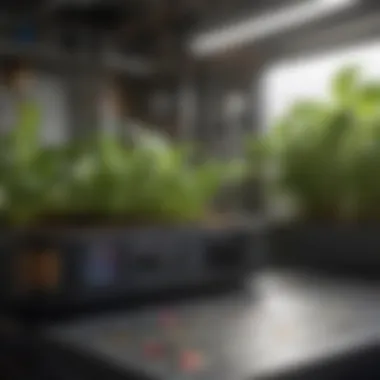

Key Components of Grow Boxes
Understanding the key components of climate-controlled grow boxes is essential for optimizing plant growth and ensuring a productive cultivation environment. These elements not only contribute to the overall functionality of the system but also create a precise ecosystem for plants to thrive. Grow boxes incorporate various systems that work synergistically to support healthy plant development while addressing the challenges of indoor agriculture.
Lighting Systems
Lighting systems play a crucial role in plant growth, influencing development stages significantly.
Types of Lights
Different types of grow light technology are used in climate-controlled grow boxes. LED lights are among the most popular choices due to their energy efficiency and long lifespan. They emit specific light spectrums that cater to plant needs, promoting both vegetative and flowering stages. Another common option, HID lights, provide a high-intensity output which can lead to faster growth; however, they produce more heat and require additional cooling efforts.
The unique feature of LED lights is their low heat output, which allows them to be placed closer to plants without risk of damage. This results in energy savings and healthier plants. Meanwhile, HID lights excel in output but may increase cooling costs.
Light Duration and Intensity
The duration and intensity of light are vital factors in controlling plant growth cycles. Plants require specific light durations to trigger growth phases such as germination and flowering. The beneficial aspect of programmable light timers allows growers to simulate day-night cycles that plants naturally experience in outdoor settings.
Different species require varying intensities of light. Too much light can lead to stress, while too little can stunt growth. Finding the balance between light duration and intensity is key for cultivating optimal growth conditions.
Temperature Control
Temperature control is another fundamental component within climate-controlled grow boxes. Plants thrive within specific temperature ranges that encourage physiological processes.
Heating Methods
There are several heating methods used to maintain the desired temperature in a grow box. Electric heaters are commonly utilized for their ease of use and adjustable settings. Another option, infrared heaters, warm up objects rather than the air, providing more efficient heating for plant surfaces. The key characteristic of efficient heating methods is their ability to maintain a stable temperature without significant fluctuations, which is vital for plant health.
However, electric heaters may increase energy consumption, creating a potential disadvantage. Careful monitoring is necessary to mitigate costs.
Cooling Systems
Cooling systems help prevent overheating within a grow box. Air conditioning units specifically designed for agriculture can effectively reduce temperature without drastic energy use. Alternatively, ventilation fans can help circulate air and maintain a cooler environment.
The key aspect of effective cooling is balancing air intake and exhaust to create ideal conditions. Monitoring humidity levels during cooling is important as it keeps plants healthy.
Humidity Management
Humidity management ensures an appropriate moisture level within the grow box, which is critical for plant respiration.
Humidity Control Devices
Various devices are available to manage humidity levels. Dehumidifiers are utilized to lower excess moisture, while humidifiers add moisture when the air becomes too dry. The key characteristic of advanced humidity control devices is their ability to automate systems, enhancing efficiency and reducing manual monitoring.
An advantage of tightly controlled humidity is the prevention of mold and mildew, which can devastate plant crops. However, these devices require consistent maintenance.
Impact on Plant Growth
Proper humidity levels directly affect plant health and growth rates. Plants transpire moisture through their leaves, and correct humidity ensures efficient nutrient uptake. The beneficial aspect of optimal humidity conditions is enhanced growth rates and better yield quality.
If humidity is too high, the risk of disease outbreaks increases, while low humidity can cause water stress. Thus, maintaining the right balance is crucial for encouraging healthy growth.
Ventilation Strategies
Ventilation is important for maintaining air quality and temperature in grow boxes.
Airflow Dynamics
Understanding airflow dynamics assists in creating an environment where fresh air circulates effectively. Ventilation fans can help monitor and maintain air movement, allowing for a steady exchange of carbon dioxide and oxygen. The key benefit of proper airflow is preventing stagnant conditions that can lead to disease.
Designing the space with proper airflow directions can ensure every plant receives optimal air exposure, leading to a more uniform growth pattern.
Exhaust Systems
Exhaust systems work in tandem with air circulation systems to remove warm air from the grow box, reducing heat buildup. Active exhaust fans can pull out hot air while drawing in cooler air, maintaining a stable environment.
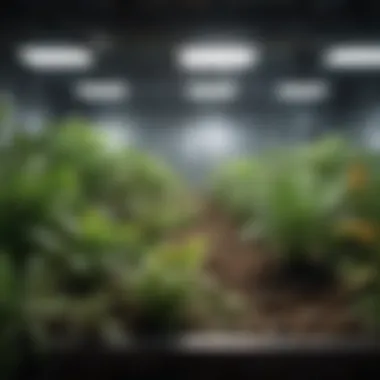
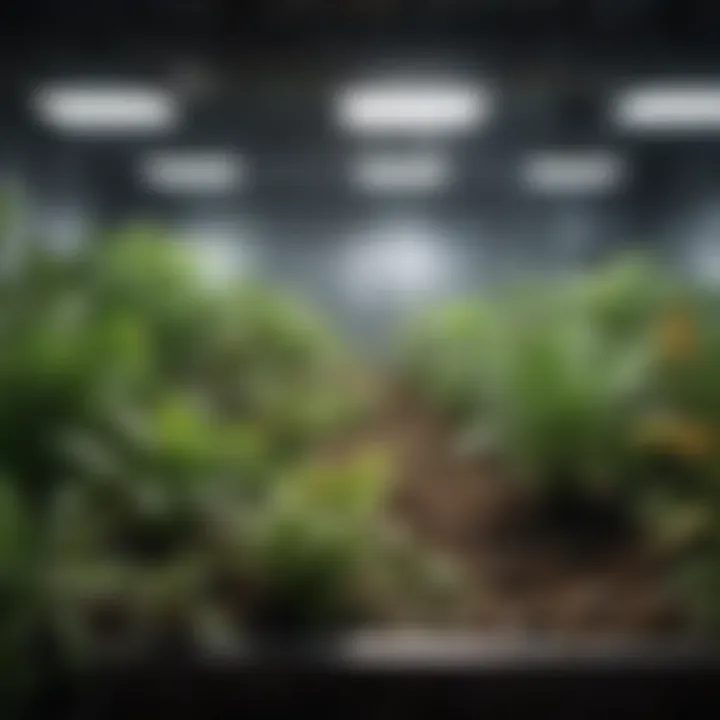
The key feature of efficient exhaust systems is their capability to react to temperature changes, offering real-time adjustments to keep conditions ideal. However, improper exhaust design can lead to air pressure issues within the box, compromising performance.
Effective management of these key components in climate-controlled grow boxes greatly enhances the overall productivity and health of plants.
By thoroughly understanding each component, growers can make informed decisions about their setup. This ensures both efficiency and sustainability in their cultivation practices, ultimately contributing to successful agricultural outcomes.
Benefits of Using Climate Controlled Grow Boxes
Climate-controlled grow boxes provide numerous advantages for modern agricultural practices. These benefits are essential for improving yield, promoting sustainability, and facilitating efficient use of resources. Understanding the key benefits of using these systems offers valuable insight for both new growers and experienced farmers.
Optimized Growth Conditions
One of the primary advantages of climate-controlled grow boxes is the ability to create and maintain optimal growing conditions for plants. Grow boxes allow precise control over lighting, temperature, and humidity levels. This means that plants can thrive regardless of external weather conditions, which often fluctuate.
For instance, tropical plants can be cultivated in regions with varying climates, ensuring that all plants receive the required amount of light with specific intensity. This increases growth rates and improves overall plant health.
"Consistent conditions lead to predictable outcomes in crop yield and quality."
By using various lighting systems, like LED or fluorescent lights, farmers can replicate natural sunlight to enhance photosynthesis. Furthermore, regulating temperature and humidity can help in preventing issues such as overheating or cold stress, which can limit growth. Ultimately, optimized growth conditions translate into enhanced productivity and profitability for growers.
Pest and Disease Control
Another significant benefit of climate-controlled grow boxes is the enhanced ability to manage pests and diseases. In a controlled environment, farmers can minimize exposure to harmful insects and pathogens that might otherwise thrive in traditional outdoor settings.
Advanced filtering and ventilation systems reduce the chances of pest infestations by maintaining cleaner air flow within the grow box. Moreover, the controlled environment enables the use of organic and integrated pest management strategies.
By effectively monitoring humidity and temperature, potential conditions for mold, mildew, or other plant diseases can be avoided. This proactive approach saves farmers time and money on chemical treatments and pesticide applications, providing a healthier alternative for both plants and consumers.
Resource Efficiency
Resource efficiency is another crucial aspect of utilizing climate-controlled grow boxes. These systems are designed to use water, nutrients, and energy more effectively than traditional farming practices.
For example, the recirculation of water and nutrients allows for precise application, reducing waste and ensuring that plants receive the correct amounts essential for growth. This is particularly important in regions where water resources are limited, making it possible for growers to participate in sustainable agriculture practices.
Additionally, energy-efficient technologies, such as LED lighting and advanced climate monitoring devices, contribute to reduced energy consumption. This not only lowers operational costs but also minimizes the carbon footprint associated with agricultural production.
In summary, the benefits of using climate-controlled grow boxes encompass optimized growth conditions, improved pest and disease control, and enhanced resource efficiency. These advantages underscore the relevance and necessity of adopting such systems in contemporary agricultural practices. Their importance extends beyond individual benefits, representing a shift toward more sustainable and productive farming methodologies.
Applications of Climate Controlled Grow Boxes
The applications of climate-controlled grow boxes extend beyond mere hobbyist interests. They occupy a significant place in modern agricultural practices by optimizing various aspects of cultivation. These specialized environments are designed to provide ideal conditions for plant growth—adjusting for factors like temperature, light, humidity, and air circulation. This ensures plants receive all necessary elements to thrive, making them essential for different user groups including commercial farmers, home gardeners, and research institutions.
Commercial Farming
Climate-controlled grow boxes significantly enhance productivity in commercial farming. By mimicking ideal conditions year-round, they create a stable environment for crops to flourish regardless of external weather conditions. This method leads to higher yield per square foot compared to traditional farming.
- Pest and Disease Management: The controlled environment minimizes exposure to pests and diseases, reducing reliance on pesticides.
- Water Efficiency: With better control over moisture, farmers can limit water waste, which is critical in water-scarce regions.
- Crop Variety: Farmers can grow a wider range of crops, including those that are not suited to their local climate, expanding their market reach.
Overall, the investment in climate-controlled grow boxes can lead to increased profitability and sustainability in commercial operations.
Home Gardening
For home gardeners, climate-controlled grow boxes offer an innovative solution to growing a variety of plants in limited space. They allow individuals to cultivate gardens that can be customized to their needs, irrespective of the season or outside climate conditions.
- Convenience: Grow boxes simplify gardening by automating light, water, and nutrients, leaving less room for error.
- Space Utilization: Ideal for urban settings, these boxes maximize vertical space, allowing for dense plant arrangements.
- Personalized Gardening: Gardeners can experiment with different plant species and varieties, tailoring their gardening experience to their preferences.
Home gardening with climate-controlled systems encourages sustainable practices by providing a more efficient way to produce food.
Research and Education
Institutions devoted to research and educational programs benefit tremendously from climate-controlled grow boxes. The controlled environments facilitate accurate and replicable scientific studies.
- Experimental Growth Conditions: Researchers can manipulate variables like light, humidity, and temperature to study plant responses effectively.
- Educational Tools: Grow boxes serve as hands-on learning tools for students, allowing them to observe plant biology in a controlled setting.
- Sustainable Innovation: Researchers can explore advancements in agricultural technology, contributing to future agricultural practices.
In summary, the applications of climate-controlled grow boxes highlight their versatility and importance. They cater to various stakeholders by enhancing efficiency, promoting sustainability, and driving innovation in agriculture.
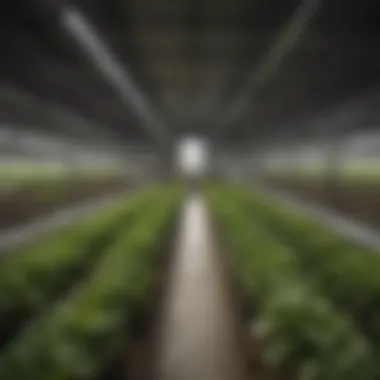
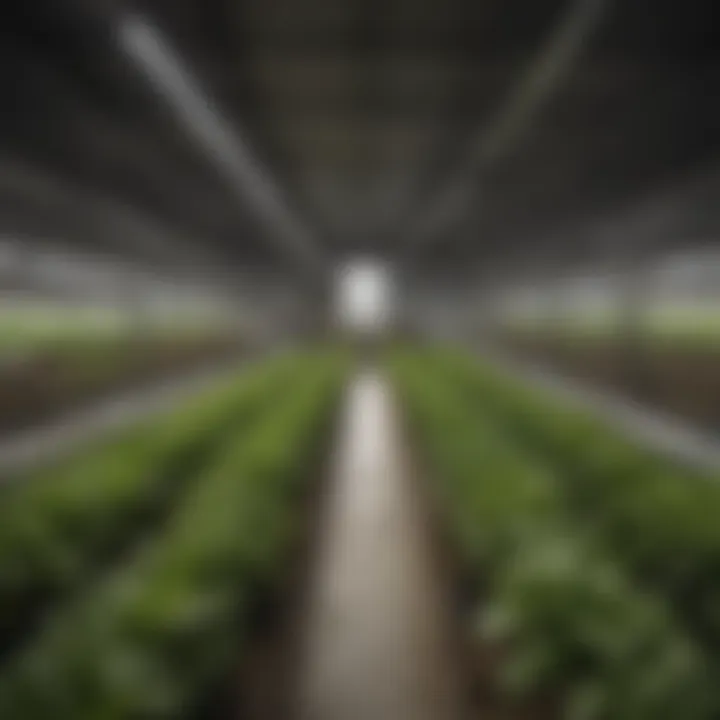
Challenges and Considerations
Understanding the challenges and considerations involved in utilizing climate-controlled grow boxes is essential for anyone looking to optimize their agricultural practices. While these systems offer numerous advantages, they also come with specific hurdles that must be navigated to ensure successful cultivation. This section explores the important aspects of initial setup costs, maintenance requirements, and the level of technical knowledge needed to operate these systems effectively.
Initial Setup Costs
The initial investment required for a climate-controlled grow box can be significant. Prices vary widely depending on the size, features, and brand of the system. Commonly, costs encompass not only the grow box itself but also essential components such as lighting, ventilation, and temperature control systems.
- Types of Expenses:
- Box Purchase: Ranges based on size and brand.
- Installation Costs: Professional help may be necessary, adding to expenses.
- Supplementary Equipment: Sensors and monitoring systems can increase investment.
It is vital to conduct a cost analysis prior to making a purchase. Assessing potential returns on investment by comparing yields from conventional methods to those from climate-controlled environments can provide insights into the feasibility of the project.
Maintenance Requirements
Maintaining a climate-controlled grow box involves regular monitoring and upkeep. These systems require routine checks to ensure optimal performance, which can be time-consuming. Key maintenance tasks include:
- Regular Cleaning: Debris and dust accumulation can interfere with airflow and light penetration.
- Equipment Checks: Regular inspection of lighting, fans, and temperature control units is necessary.
- System Calibration: Ensuring that sensors and controls are calibrated correctly is essential for accuracy.
Failure to maintain these aspects can result in diminished plant health and ultimately, lower yields. Therefore, establishing a systematic maintenance routine is crucial for long-term success in using grow boxes.
Technical Knowledge
A certain level of technical knowledge is essential for operating climate-controlled grow boxes effectively. Users must understand the systems in use and have the ability to troubleshoot issues that may arise. This need manifests in several areas:
- Understanding the Technology: Familiarity with how different components operate and interact is vital.
- Problem Solving: Knowledge in specific areas can help in addressing issues, such as temperature fluctuations or humidity levels.
- Adjusting Parameters: Users should be comfortable in adjusting environmental conditions based on plant needs.
For those lacking experience, education resources are critical. Online forums, manuals, and community resources can bridge gaps in knowledge.
Investing in a climate-controlled grow box presents unique challenges. Understanding them is essential for achieving successful outcomes in modern agriculture.
Future Trends in Climate Controlled Cultivation
Climate controlled grow boxes represent more than just a temporary trend; they embody the future of agricultural practices. With the increasing need for sustainable farming methods, these innovations are evolving rapidly. Exploring the advancements and sustainability practices in this area reveals the paths agriculture is likely to take. This is not just important for farmers but also for everyone involved in maintaining global food security.
Advancements in Technology
Technology has laid the groundwork for substantial improvements in climate controlled cultivation. Several key advancements are paving the way for more efficient farming methods:
- Automated Systems: Automation in climate control allows for precise adjustments tailored to the specific growth needs of plants. Sensors monitor factors like temperature, humidity, and light, making real-time adjustments easier.
- Smart Irrigation: Advanced systems reduce water waste. They can function on a schedule or adjust variables based on the moisture levels in soil, ensuring that plants receive adequate water without flooding.
- LED Lighting: Energy-efficient and long-lasting, LED grow lights can be tuned to provide specific wavelengths favorable for different growth stages.
"The integration of smart technologies in agriculture is not just beneficial; it's essential for future food production."
These significant advancements lead to optimized growth conditions which directly benefit yield and resource management. Each of these technologies also promotes a more user-friendly experience for growers. As farmers adopt these advancements, they could increase crop productivity while minimizing inputs.
Sustainability Practices
The agricultural sector faces ongoing pressures to adopt sustainable practices. In climate controlled grow boxes, this tension turns into a fruitful opportunity for innovation:
- Reduce Carbon Footprint: By implementing energy-efficient systems, such as solar panels and efficient heating techniques, growers can significantly lower emissions involved in food production.
- Recycling Nutrients: Systems that focus on recirculating water and nutrients help in maintaining eco-friendliness. This approach also reduces the need for synthetic fertilizers, promoting healthier soil.
- Organic Growing: Many advanced grow boxes allow for organic gardening, which fosters soil health and biodiversity. This movement toward organic solutions is growing among consumers.
These sustainability practices not only highlight a commitment to environmental stewardship but also cater to an increasingly eco-conscious consumer base. The shift toward eco-friendly methodologies is critical to ensure that future farming does not compromise the planet's well-being.
Culmination
In this article, we have examined the multifaceted nature of climate controlled grow boxes. These systems play an essential role in modern agriculture. The significance of understanding their components and operations cannot be overstated.
Recap of Key Points
Climate controlled grow boxes offer a range of benefits:
- Optimized growth conditions: They create and maintain ideal environments for various plant species.
- Pest and disease control: Their closed systems limit external threats.
- Resource efficiency: In terms of water and energy, they often provide a more sustainable approach to agriculture.
The analysis also covered key components such as lighting systems, temperature control, humidity management, and ventilation strategies. Each of these elements directly impacts plant growth and productivity. Additionally, we discussed the various applications of these systems, including commercial farming and home gardening.
Encouraging Further Exploration
As technology continues to evolve, so do the possibilities within climate controlled cultivation. It is crucial for agriculture farmers and enthusiasts to stay informed about advancements. Engaging with communities such as those on Facebook can provide insights and innovative ideas.
The future of agriculture looks promising with the integration of sustainable practices in these systems. Researchers and home gardeners alike should explore ongoing developments in this field to enhance their own practices.















